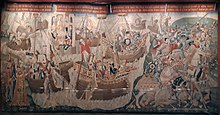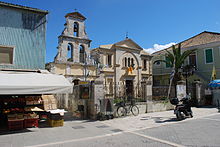Lefkada
Lefkada
Λευκάδα | |
|---|---|
UTC+3 (EEST) | |
| Website | lefkada |
Lefkada (Greek: Λευκάδα, Lefkáda, [lefˈkaða]), also known as Lefkas or Leukas[2] (Ancient Greek and Katharevousa: Λευκάς, Leukás, modern pronunciation Lefkás) and Leucadia, is a Greek island in the Ionian Sea on the west coast of Greece, connected to the mainland by a long causeway and floating bridge. The principal town of the island and seat of the municipality is Lefkada.[3] It is situated on the northern part of the island, approximately 25 minutes by automobile away from Aktion National Airport. The island is part of the regional unit of Lefkada.
Geography

Lefkada measures 35 kilometres (22 miles) from north to south, and 15 kilometres (9 miles) from east to west. The area of the island is about 302 square kilometres (117 sq mi), the area of the municipality (including the islands Kalamos, Kastos and several smaller islets) is 333.58 km2 (128.80 sq mi).
20 kilometres (12 miles) south of Nidri is the resort of
The famous beach of Porto Katsiki is located on Lefkada's west coast. Lefkada was attached to mainland Greece (see below about Homer's Ithaca being Lefkada). The Corinthians dug a trench in the 7th century BC on its isthmus.[7]
The southernmost tip of the island is called Cape Dukato, a name sometimes applied to the whole island.
Climate


The island has a typical Mediterranean climate with hot summers and cool winters, or Csa according to the Köppen climate classification system.
History
Antiquity
The stories of

The ancient town was founded in the 7th century BC, somewhat to the south of the modern capital of the island.[10] During the Peloponnesian War, Leucas joined the Peloponnesian League.[11]
The town was conquered during the 3rd century by Agathocles of Syracuse.
Middle Ages
Byzantine period
No information survives on the island during the early Byzantine period,[12] when the town possibly disappeared in the turmoils of the Migration Period.[10] Nevertheless, unlike the Epirote mainland, where widespread Slavic settlement is attested from the late 6th until mid-8th centuries,[13] only a handful of traces attest to a Slavic settlement in Lefkada.[12]
Information continues to be sparse during the middle Byzantine period. The island is attested as a bishopric at the
Epirote and Latin rule
The
The name Santa Maura is first attested for the island and its capital in 1292, when Genoese ships in Byzantine employ raided it.

The Orsini family lost Lefkada in 1331 to
In 1413, the Prince of Achaea, Centurione II Zaccaria, launched an attack on Lefkada and its castle with Albanian mercenaries, but were defeated with help from the Republic of Venice.[14] The Ottomans captured most of Epirus[10] and raided the island, leading the Tocci to consider ceding it to the Venetians.[12]
Faced with expanding Ottoman power in the mainland, the Tocci became vassals of the Ottoman sultans.
Ottoman period
The Ottomans called the island Levkada (
A lack of water led to the construction of a 3 kilometres (1.9 mi) long
In the 17th century, Lefkada became a separate sanjak within the Eyalet of the Archipelago, although according to
According to the descriptions of travellers like Evliya, Lefkada was an urban centre of some importance, boasting "two of the largest works of Ottoman civil and military architecture in the Western Balkans", namely the aqueduct built by Sultan
Venetian period


The island was conquered by the Venetians under Francesco Morosini following a sixteen-day siege in 1684, during the opening stages of the Morean War.[23][28] Morosini evacuated the walled town and demolished both it and the two suburbs directly outside the walls, turning them into the castle's glacis. Only the island suburb remained, known as "Amaxiki" until the 19th century. With the evicted inhabitants settling there, this became the main town of the island, the predecessor of the modern city of Lefkada. The Venetians also removed all buildings associated with Islam.[28]
The Venetians modernized the castle in the 1710s, removing the last traces of the medieval castle and adding
Venetian rule over the island was uninterrupted, apart from a rebellion of the local Greeks in 1769, until the Fall of the Republic of Venice in 1797.[28]
Post-Venetian period until the union with Greece
Following the end of the Republic of Venice in 1797, Lefkada, like the other
Much of the town, including the Ottoman aqueduct, was destroyed in an earthquake in 1825. After this, the town was rebuilt in wood to prevent similar damage.
Lafcadio Hearn Historical Center
The first museum in Europe for Lafcadio Hearn, who was born on the island and is named after it, was inaugurated in Lefkada on July 4, 2014, as Lafcadio Hearn Historical Center. It contains early editions, rare books and Japanese collectibles. The visitors, through photos, texts and exhibits, can wander in the significant events of Lafcadio Hearn's life, and also in the civilizations of Europe, America and Japan of late 19th and early 20th centuries through the open mind of his lectures, writings and tales. The municipalities of Kumamoto, Matsue, Shinjuku, Yaizu, as well as Toyama University, the Koizumi family, and other people from Japan and Greece contributed to the establishment of the Lafcadio Hearn Historical Center.

Municipality
The present municipality of Lefkada was formed in the 2011 local government reform by the merger of the following 7 former municipalities, which became municipal units:[3]
The municipality covers the island of Lefkada and the smaller islands of Kastos and Kalamos.
Education
Regional Development department, part of Ionian university based in Lefkada.[36]
Transport
Notable people

(in chronological order)
- Marcos Christino Fioravanti (1775–1862), co-founder of Santo Antônio da Patrulha in Brazil
- Frederick Temple (1821–1902), Archbishop of Canterbury
- Aristotelis Valaoritis (1824–1879), poet and politician
- Lafcadio Hearn (1850–1904), Greco-Irish-Japanese orientalist and writer, born on and named after the island
- Petros Soumilas (1861–1955), Greek Army officer who reached the rank of lieutenant general.
- Dimitrios Golemis (1874–1941), athlete
- Aggelos Sikelianos (1884–1951), poet and playwright
- Tzavalas Karousos or Karoussos (1904–1969), actor
- Aristotle Onassis, (1906–1975), Greek shipping tycoon
- Panos Rontoyannis (1911–1996), philologist and historian
- Theodoros Stamos (1922–1997), Greek-American painter
- Apostolos Kaklamanis (1936-), politician
- Evaggelos Vlassopoulos (1935–2002), politician
- George Ktenas (1938–2004), politician
- Agnes Baltsa (1944-), opera singer
- Spyros Vrettos (1960-), poet
- Spiros Marangos(1967-), footballer
- Marina Lambrini Diamandis(1985-), singer and songwriter
Gallery
-
Traditional street of Lefkada (city)
-
Panagia ton Xenon, Lefkada city
-
Porto Katsiki beach
-
Kalamos village
-
Traditional dress
See also
Notes
- ^ "Αποτελέσματα Απογραφής Πληθυσμού - Κατοικιών 2021, Μόνιμος Πληθυσμός κατά οικισμό" [Results of the 2021 Population - Housing Census, Permanent population by settlement] (in Greek). Hellenic Statistical Authority. 29 March 2024.
- ISBN 978-0-19-975416-8. Retrieved 16 June 2011.
- ^ a b "ΦΕΚ A 87/2010, Kallikratis reform law text" (in Greek). Government Gazette.
- ^ "Population & housing census 2001 (incl. area and average elevation)" (PDF) (in Greek). National Statistical Service of Greece. Archived from the original (PDF) on 2015-09-21.
- ^ "Oreivatein.com". Archived from the original on 2012-12-09. Retrieved 2012-02-21.
- ^ Strabo 10.2.20
- ^ Strabo 10.452
- ISBN 0-7190-0059-9
- ISBN 978-1473849181.
- ^ a b c d e f g h Kiel 1986, p. 725.
- ISBN 0-312-34215-2.
- ^ a b c d e f g h i j k Soustal & Koder 1981, p. 195.
- ^ Soustal & Koder 1981, pp. 51–52.
- ^ a b c Soustal & Koder 1981, pp. 195, 203.
- ^ a b c Brooks 2013, p. 102.
- ^ Soustal & Koder 1981, p. 203.
- ^ Brooks 2013, p. 287.
- ^ Brooks 2013, pp. 102, 287.
- ^ Fine 1994, pp. 348–351.
- ^ Soustal & Koder 1981, pp. 70–71.
- ^ Kiel 1986, pp. 725–726.
- ^ a b c d Kiel 1986, p. 726.
- ^ a b Soustal & Koder 1981, p. 196.
- ^ Kiel 1986, pp. 725, 726, 737.
- ^ Kiel 1986, pp. 725, 726.
- ^ Birken 1976, pp. 61, 103.
- ^ Kiel 1986, pp. 726–727.
- ^ a b c d e f g h i Kiel 1986, p. 727.
- ^ Brooks 2013, p. 103.
- ^ Brooks 2013, pp. 103–104.
- ^ Nicholas Charles Pappas (1982). Greeks in Russian military service in the late eighteen and early nineteenth centuries. Stanford University.
These troops were recruited from among the fugitive klephtes and armatoloi residing on the Ionian Islands, particularly Lefkas. Among these men were the Captains Anastasios Tselios and Apostolos Levendakls. Tselios was a member of a prominent family of armatoloi from Xeromeros in southwestern Greece. As early as 1802, he had offered his services to the Septinsular Republic, proposing to raise and command a company of sixty men on Lefkas. ... In April 1806, this kapitanios and his men were among a number of refugee armatoloi on Lefkas. including the kapitanaioi Skylodemos, Stratos, Giannes Kolovelones, Konstantes Poules, Giorgakes — — 72 Varnakiotes and others. By June ...
- ^ Moschonas 1975, p. 399.
- ^ Brooks 2013, p. 104.
- ^ Moschonas 1975, pp. 399–400.
- ^ Kiel 1986, pp. 727–728.
- ^ "Τοποθεσια – Τμήμα Περιφερειακής Ανάπτυξης".
Sources
- ISBN 3-920153-56-1.
- Brooks, Allan (2013). Castles of Northwest Greece: From the Early Byzantine Period to the Eve of the First World War. Aetos Press. ISBN 978-0-9575846-0-0.
- ISBN 0-472-08260-4.
- Kiel, M. (1986). "Levkas". In ISBN 978-90-04-07819-2.
- Moschonas, Nikolaos (1975). "Τα Ιόνια Νησιά κατά την περίοδο 1797-1821" [The Ionian Islands in the period 1797-1821]. Ιστορία του Ελληνικού Έθνους, Τόμος ΙΑ′: Ο ελληνισμός υπό ξένη κυριαρχία, 1669–1821 [History of the Greek Nation, Volume XI: Hellenism under foreign rule, 1669–1821] (in Greek). Athens: Ekdotiki Athinon. pp. 382–402.
- Soustal, Peter; Koder, Johannes (1981). Tabula Imperii Byzantini, Band 3: Nikopolis und Kephallēnia (in German). Vienna: ISBN 978-3-7001-0399-8.
- Zečević, Nada (2014). The Tocco of the Greek Realm: Nobility, Power and Migration in Latin Greece (14th-15th centuries). Belgrade: Makart. ISBN 9788691944100.
External links
- Lefkada Travel Guide
- Municipal Port Fund of Lefkada Official page
- Lefkada Prefecture
- The official page of Greek National Tourism Organization
- . Encyclopædia Britannica. Vol. XXI (9th ed.). 1886. p. 297.
- Map of Homer's Ithaka (Lefkada), Same and Asteris according to Wilhelm Dörpfeld. Digital library of Heidelberg University.
- Photo of Dörpfeld's excavation site at Lefkada near Nydri, early in the 20th century. Digital library of Heidelberg University.
- Lafcadio Hearn Historical Center
- Lefkada Official App






